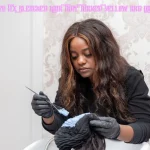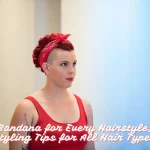Fashion accessories are the finishing touches that can transform an outfit from ordinary to extraordinary. Among these, bandanas and kerchiefs stand out as versatile, stylish, and timeless options. But what exactly sets them apart? Whether you’re a fashion enthusiast or someone looking to elevate your style, understanding the differences between bandanas and kerchiefs can help you make the right choice for any occasion. In this article, we’ll explore their history, styling options, and practical uses, along with personal anecdotes and expert insights to guide you.
A Brief History of Bandanas and Kerchiefs
Both bandanas and kerchiefs have fascinating histories that reflect their cultural significance and versatility.
Bandanas: From Practicality to Pop Culture
The term “bandana” comes from the Hindi word “bandhna,” meaning “to tie.” Originating in South Asia, bandanas were initially used as large pieces of cloth for practical purposes, such as protecting against dust and sun. In 19th-century America, bandanas became a staple for cowboys and farmers, often worn around the neck or tied to hats.
Bandanas gained further popularity during the counterculture movements of the 1960s, symbolizing rebellion and individuality. Today, they remain a favorite for their bold patterns and casual vibe.
Kerchiefs: Elegance Through the Ages
Kerchiefs have a rich history dating back to medieval Europe. The term comes from the French word “couvrir,” meaning “to cover.” Originally used as head coverings, kerchiefs were made from fine fabrics like silk and lace, often adorned with intricate designs.
Over time, kerchiefs evolved into a fashion accessory, worn around the neck, in the hair, or even as a belt. They are synonymous with elegance and sophistication, making them a timeless choice for those seeking a polished look.
Here’s a table summarizing the key differences between bandanas and kerchiefs, making it easy for readers to understand their unique characteristics and styling options:
| Aspect | Bandana | Kerchief |
|---|---|---|
| Material | Cotton or polyester; durable and casual. | Silk, satin, or cotton blends; finer and more elegant. |
| Size | Larger (22” x 22”); versatile for various styles. | Smaller (18” x 18”); sleek and polished. |
| Design | Bold patterns (e.g., paisley) and vibrant colors. | Subdued patterns and classic colors; timeless elegance. |
| Styling Options | – Headband – Necktie – Bag accessory – Pocket square |
– Neck scarf – Hair accessory – Belt |
| Best For | Casual outings, outdoor activities, festivals, and street style. | Formal events, work attire, weddings, and brunch dates. |
| Vibe | Playful, youthful, and edgy. | Sophisticated, elegant, and timeless. |
Styling Comparison
| Occasion | Bandana Styling | Kerchief Styling |
|---|---|---|
| Outdoor Adventures | Wear as a headband or necktie for a casual, functional look. | Not typically used for outdoor activities. |
| Festivals | Tie around the head or neck for a bold, statement look. | Less common for festivals; better suited for formal settings. |
| Work Events | Too casual for professional settings. | Wear as a neck scarf or hair accessory for a polished look. |
| Weddings/Formal Events | Not ideal for formal occasions. | Perfect for elevating a dress or suit with a silk kerchief. |
| Brunch Dates | Add a playful touch to casual outfits. | Add a chic, elegant flair to casual outfits. |
Pros and Cons
| Accessory | Pros | Cons |
|---|---|---|
| Bandana | – Versatile and casual. – Bold patterns make a statement. – Affordable. |
– Too casual for formal events. – Limited to casual styling. |
| Kerchief | – Elegant and sophisticated. – Suitable for formal and casual settings. – Timeless appeal. |
– More expensive due to finer materials. – Less bold in design. |
Quick Tips for Choosing
| Tip | Bandana | Kerchief |
|---|---|---|
| When to Wear | Casual outings, outdoor activities, and festivals. | Formal events, work settings, and elegant occasions. |
| How to Style | Fold into a triangle and tie as a headband, necktie, or bag accessory. | Fold into a triangle and tie as a neck scarf, hair accessory, or belt. |
| Material Matters | Choose cotton for durability and comfort. | Opt for silk or satin for a luxurious feel. |
This table format provides a clear, easy-to-understand breakdown of the differences between bandanas and kerchiefs, their styling options, and when to choose each accessory. It’s perfect for readers looking to make informed fashion choices!
Key Differences Between Bandanas and Kerchiefs
While bandanas and kerchiefs may seem similar, they have distinct characteristics that set them apart.
1. Material and Design
- Bandanas: Typically made from cotton or polyester, bandanas feature vibrant patterns, often with paisley designs or bold colors. They are larger, usually measuring around 22 inches by 22 inches, allowing for versatile styling.
- Kerchiefs: Crafted from finer materials like silk, satin, or cotton blends, kerchiefs are smaller (around 18 inches by 18 inches) and feature more subdued patterns and colors, focusing on classic elegance.
2. Styling Versatility
- Bandanas: Known for their casual, playful vibe, bandanas can be worn as headbands, neckties, or even tied to bags. Fashion influencer Leandra Medine notes, “I love the playful and youthful vibe of a bandana.”
- Kerchiefs: Lean towards sophistication, often worn around the neck, in the hair, or as a belt. Stylist Rachel Zoe describes kerchiefs as “a more classic and elegant option, perfect for a sophisticated look.”
When to Choose a Bandana
Bandanas are perfect for casual outings, outdoor activities, or when you want to add a touch of individuality to your look.
1. Outdoor Adventures
Whether you’re hiking, camping, or spending a day at the beach, a bandana can keep sweat at bay and protect your hair from the elements.
Personal Anecdote: During a summer road trip, I packed a few bandanas in different colors. They became my go-to accessory—used as headbands, neckties, and even makeshift washcloths. Their versatility made them indispensable!
2. Festival Fashion
Music festivals are all about bold fashion statements. A brightly colored bandana can add a fun, edgy touch to your outfit, helping you stand out in the crowd.
3. Street Style
Pairing a bandana with a denim jacket or oversized t-shirt creates a trendy streetwear look, perfect for casual outings with friends.
When to Choose a Kerchief
Kerchiefs are ideal for formal events or when you want to elevate your everyday style.
1. Work Events
A silk kerchief can add a touch of sophistication to a blazer or dress shirt, making it perfect for professional settings.
Personal Anecdote: At a family wedding, I wore a silk kerchief around my neck with my dress. It instantly elevated my look, and I received countless compliments throughout the evening.
2. Weddings and Formal Gatherings
A kerchief can enhance a formal dress or suit, giving a polished and elegant vibe.
3. Brunch Dates
A patterned kerchief can add a chic touch to a casual outfit, making it perfect for a brunch date with friends.
Styling Tips for Bandanas and Kerchiefs
Bandana Styling Ideas
- Headband: Fold the bandana into a triangle, roll it into a strip, and tie it around your head for a retro look.
- Necktie: Fold the bandana into a triangle, roll it into a strip, and tie it around your neck for a casual, laid-back vibe.
- Bag Accessory: Tie a bandana to the handle of your bag for a pop of color and personality.
Kerchief Styling Ideas
- Neck Scarf: Fold the kerchief into a triangle, roll it into a strip, and tie it around your neck for a polished look.
- Hair Accessory: Use a kerchief as a headband or tie it into a bow for a chic hairstyle.
- Belt: Thread a kerchief through your belt loops for a unique and stylish touch.
Expert Insights on Styling Bandanas and Kerchiefs
To help you navigate the world of bandanas and kerchiefs, let’s look at some expert insights from fashion influencers and designers.
Chiara Ferragni, Fashion Blogger
“A bandana can be a bold statement piece or a subtle accessory. It’s all about how you style it.”
Philippa Price, Accessories Designer
“Kerchiefs are more versatile and can be styled in a variety of ways, making them suitable for any occasion.”
Studies on Fashion Accessories
Several studies have explored the significance of fashion accessories like bandanas and kerchiefs, shedding light on their cultural implications and popularity.
- “The Cultural Significance of Bandanas in 19th-Century America”
This study delves into the historical context and cultural implications of bandanas, highlighting their association with rebellion and individuality. - “The Evolution of the Kerchief as a Fashion Accessory”
This research traces the history and development of the kerchief, examining its transformation from a practical item to a fashionable accessory. - “A Comparative Analysis of Bandana and Kerchief Styles in Contemporary Fashion”
This study explores the differences in design, materials, and styling techniques for bandanas and kerchiefs, emphasizing their unique characteristics. - “The Impact of Social Media on the Popularity of Bandanas and Kerchiefs”
This research investigates how social media platforms have influenced the trends and popularity of these accessories, showcasing the role of influencers in shaping fashion choices.
Conclusion
In the world of fashion, understanding the differences between bandanas and kerchiefs can elevate your style and help you make informed choices about accessories. Whether you opt for the playful and bold nature of a bandana or the classic elegance of a kerchief, both accessories offer unique opportunities for self-expression.
Ultimately, it’s all about personal style and how you choose to wear these versatile accessories. So, the next time you’re looking to add a finishing touch to your outfit, consider reaching for a bandana or kerchief and enjoy the creative possibilities they bring to your wardrobe!
Key Takeaways:
- Bandanas are casual, bold, and versatile, perfect for outdoor adventures and street style.
- Kerchiefs are elegant and sophisticated, ideal for formal events and polished looks.
- Both accessories offer unique styling options, from headbands to neckties and beyond.
- Choose based on the occasion and your personal style preferences.
With this guide, you’re ready to embrace the world of bandanas and kerchiefs, adding a touch of flair to every outfit. Happy styling!




